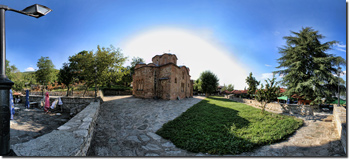|

 3.9 MB 3.9 MB
St. Panteleimon - built in 1164, Nerezi - near Skopje
In the village of Gorno Nerezi, on the slopes of the mountain Vodno, positioned on an protruded terrace that offers a panoramic view to the town of Skopje, one of the most important cultural and historic monuments is located. Its artistic value and importance go beyond the borders of our country.
It is the monastery St. Panteleimon with the church dedicated to this saint - protector of health. The monastery and the church were built during the reign of the Komnen dynasty, by a less-known member of this family. It was the prince Alexy (son of Theodora, the youngest daughter of the Byzantine emperor Alexy I Komnen, and Angel Constantine), who, by building of this monastery, has defeated the oblivion and has remained in the eternal collective memory, thanks to the beauty he bequeathed to the humanity.
The year of building and fresco-painting of this church, as can be read from the inscription on the marble plate positioned above the entrance door, is 1164. That year, the prince Alexy chose from among the best Byzantine master-builders and zographs and ordered them to build a church that will not be impressive due to its accentuated monumentality or luxury, but with an unpretentious, simple and harmonious beauty, made from the local building stone, combined by bricks. Thus, the church was built with modest dimensions, in a shape of an inscribed cross in an oblong space, with five domes - one larger and eight-sided, and four smaller.
This church has survived many disasters - fire, earthquake, various demolitions and robberies - but it is, still, the only preserved monument from the 12th century, time when Skopje was a cultural center of the Skopje eparchy.
The monastery Sveti Panteleimon is ranked among the peak achievements of the Byzantine art. For this contributes also the fresco painting that covers the walls of the church, and which is a rare challenge and delight for all lovers of timeless beauty.
The fresco-painting in the church originates from three different periods of time - the oldest is from the 12th century, the second from the times after the disastrous earthquake in 1555, and the third, the one that covers the domes, originates from the second half of the 19th century.
Most impressive is the oldest fresco-painting, by which the unknown Nerezi master has given life to the walls of the church. It is represented by the Holy Warriors and anchorites from the first zone in the naos, as well as the compositions of Great Feasts in the second zone. From among the compositions, especially worth mentioning are the Lamentation of Christ, Dormition of Holy Mother of God, and others. Impressive is the depiction of Holy Mother of God with Christ, to the left from the iconostasis, and the portrait of the patron of the church, St. Panteleimon.
|
|
|
|
|